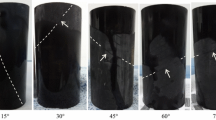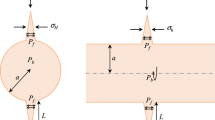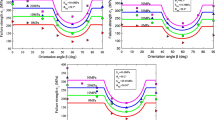Drilling mud characteristics affect the stress distribution around the borehole, while anisotropic tensile strength determines the fracture behavior of the formation, but the combined effect of these factors is rarely considered in the prediction of fracture pressure. In this work, tensile strength anisotropy of shale rock was analyzed based on the Brazilian disc test (BDT), and the corresponding anisotropic tensile criteria were reviewed and contrasted with experimental results. The N-Z (Nova – Zaninetti) criterion is adopted to describe tensile strength anisotropy of shale rock. Based on the stress distribution model and the N-Z criterion, a model of shale rock fracture under the combined action of thermal and chemical factors was constructed. The solution of the model shows that chemical and thermal factors have a different effect on pore pressure distribution around the borehole. The effect of sedimentary layers, tensile strength anisotropy, in-situ stress and pore pressure on equivalent density of fracture pressure (EDFP) was also investigated. It is shown that the EDFP decreases with increasing dip angle at a given strike of the bedding plane and reaches a minimum value when the strike of the bedding plane is along the direction of the minimum horizontal stress. The decrease in EDFP caused by tensile strength anisotropy reaches or exceeds 10% of the value calculated for isotropic conditions. The more pronounced the anisotropy of strength, the smaller the possible value of EDFP. The higher the ratio of horizontal stresses and pore pressure, the more significant the effect of anisotropy on EDFP. It is also notable that increasing the temperature of the wellbore can improve EDFP parameters and enlarge the SMDW.









Similar content being viewed by others
Change history
19 March 2020
To the article ���The Effect of Thermochemical Factors on Fracturing Pressure in Shale Rock Characterized by Tensisle Strength Anisotropy,��� by Yingjie Chen, Jianhong Fu, Yang Liu, and Feng Li, Vol. 55, No. 3, pp. 339-352, July, 2019
References
Y. Feng and K. E. Gray, SPE Journal, 23, 205–223 (2018) (SPE 187945-PA).
B. Aadnoy and R. Looyeh, Petroleum Rock Mechanics: Drilling Operations and Well Design, Gulf Professional Publishing, Oxford, UK (2011).
Y. Feng, J. F. Jones, and K. E. Gray, SPE Drilling & Completion, 31(2), 134–144 (2016).
Y. Feng, C. Arlanoglu, E. Podnos, et al., SPE Drilling & Completion, 30(1), 38–51 (2015).
J. C. Zhang and S. X. Yin, Petrol. Sci., 14 (4), 720–730 (2017).
M. K. Hubbert and D. G. Willis, AIME Petroleum Transactions, 210, 153–168 (1957).
W. R. Matthews and J. Kelly, Oil and Gas Journal, 65(8), 92–106 (1967).
B. A. Eaton, J. Petrol. Technol., 21(10), 1353–1360 (1969).
R. A. Anderson, D. S. Ingram, and A. M. Zanier, J. Petrol. Technol., 11, 1259–1268 (1973).
R. Huang, Journal of the University of Petroleum, China, 9(4), 335–346 (1984).
Z. P. Yang, B. He, L. Z. Xie, et al., Rock and Soil Mechanics, 36(12), 3447–3455 (2015).
J. Wang, L. Xie, H. Xie, et al., J. Nat. Gas Sci. Eng., 36, 1120–1129 (2016).
P. Hou, F. Gao, Y. G. Yang, et al., Chin. J. Geotech. Eng., 38, 930–939 (2016).
T. Ma, N. Peng, Z. Zhu, et al., Review and New Insights. Energies, 11(2), 304 (2018).
T. Ma, B. Wu, J. Fu, et al., J. Nat. Gas Sci. Eng., 38, 485–503 (2017).
T. Ma, Q. B. Zhang, P. Chen, et al., J. Petrol. Sci. Eng., 149, 393–408 (2017).
Y. Wang and E. Papamichos, Water Resour. Res., 30(12), 3375–3384 (2017).
G. Chen, M. E. Chenevert, M. M. Sharma, et al., J. Petrol. Sci. Eng., 38(3–4), 167–176 (2003).
G. Chen and R. T. Ewy, SPE Journal, 10(02), 121–129 (2005).
V. Vishal, S. P. Pradhan, and T. N. Singh, Geotechnical and Geological Engineering, 29(6): 1127–1133 (2011).
D. Li and L. N. Y. Wong, Rock Mech. Rock Eng., 46(2), 269–287 (2013).
B. Wu, R. Chen, and K. Xia, Int. J. Rock Mech. Min., 80, 12–18 (2015).
D. W. Hobbs, Int. J. Rock Mech. Min., 1(3), 385–396 (1964).
R. Sierra, M. H. Tran, Y. N. Abousleiman, et al., “Woodford shale mechanical properties and the impacts of lithofacies,” In: 44thUS Rock Mechanics Symposium and 5thUS-Canada Rock Mechanics Symposium, American Rock Mechanics Association (2010).
N. D. J. Simpson, “An analysis of tensile strength, fracture initiation and propagation in anisotropic rock (gas shale) using Brazilian tests quipped with high speed video and acoustic emission,” dissertation, Norwegian University of Science and Technology (2013).
D. W. Hobbs, Int. J. Rock Mech. Min., 4(1), 115–127 (1967).
K. Barron, Int. J. Rock Mech. Min., 8(6), 553–563 (1971).
R. Nova and A. Zaninetti, Int. J. Rock Mech. Min., 27(4), 231–242 (1990).
Y. K. Lee and S. Pietruszczak, Int. J. Rock Mech. Min., 79, 205–215 (2015).
M. Kurashige, Int. J. Solids Struct., 25(9), 1039–1052 (1989).
H. S. Carslaw and J. C. Jaeger, Conduction of Heat in Solids, 2nd ed., Clarendon Press, Oxford (1959).
M. Yu, M. E. Chenevert, and M. M. Sharma, J. Petrol. Sci. Eng., 38(3–4), 131–143 (2003).
M. Chen, Y. Jin, and G. Zhang, Rock Mechanics of Petroleum Engineering, Science Press, Beijing, China (2008).
G. Chen, “A study of wellbore stability in shales including poroelastic, chemical, and thermal effects,” dissertation, The University of Texas at Austin (2001).
This work was financially supported by the State Key Laboratory of Oil and Gas Reservoir Geology and Exploitation of Southwest Petroleum University (grants Nos. G201604 and PLN201611) and the National Natural Science Foundation of China (grant No. 51604230).
Author information
Authors and Affiliations
Corresponding author
Additional information
Translated from Khimiya i Tekhnologiya Topliv i Masel, No. 3, pp. 82 – 89, May – June, 2019.
Rights and permissions
About this article
Cite this article
Chen, Y., Fu, J., Liu, Y. et al. The Effect of Thermochemical Factors on Fracturing Pressure in Shale Rock Characterized by Tensisle Strength Anisotropy. Chem Technol Fuels Oils 55, 339–352 (2019). https://doi.org/10.1007/s10553-019-01037-1
Published:
Issue Date:
DOI: https://doi.org/10.1007/s10553-019-01037-1




